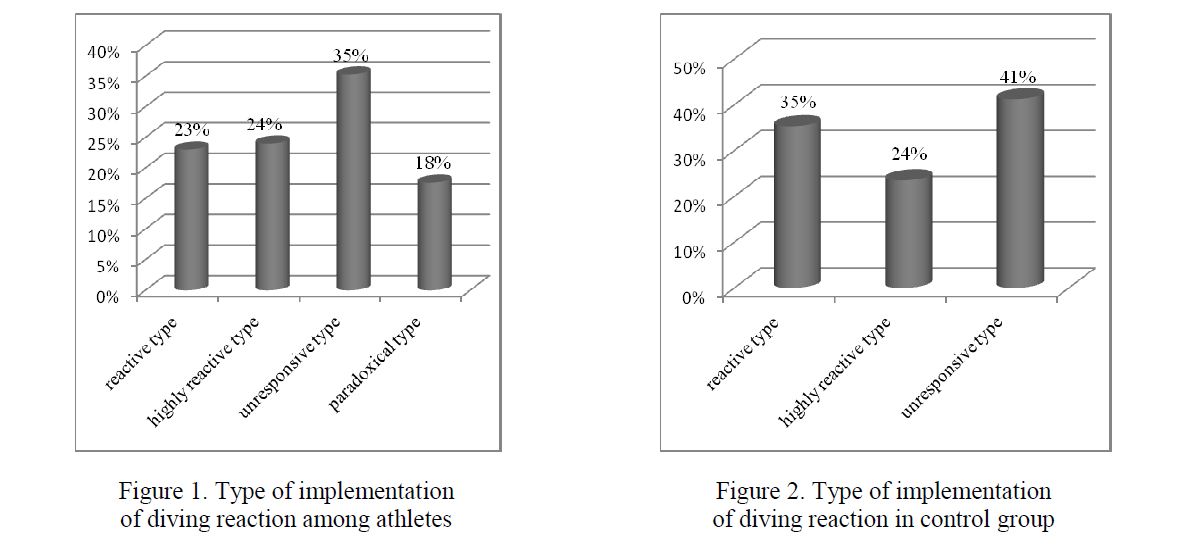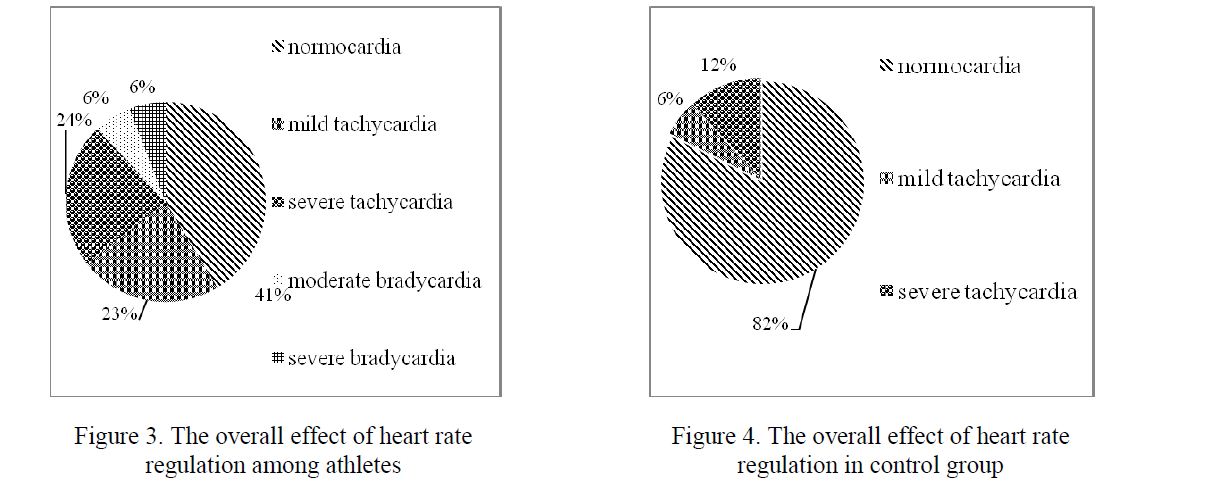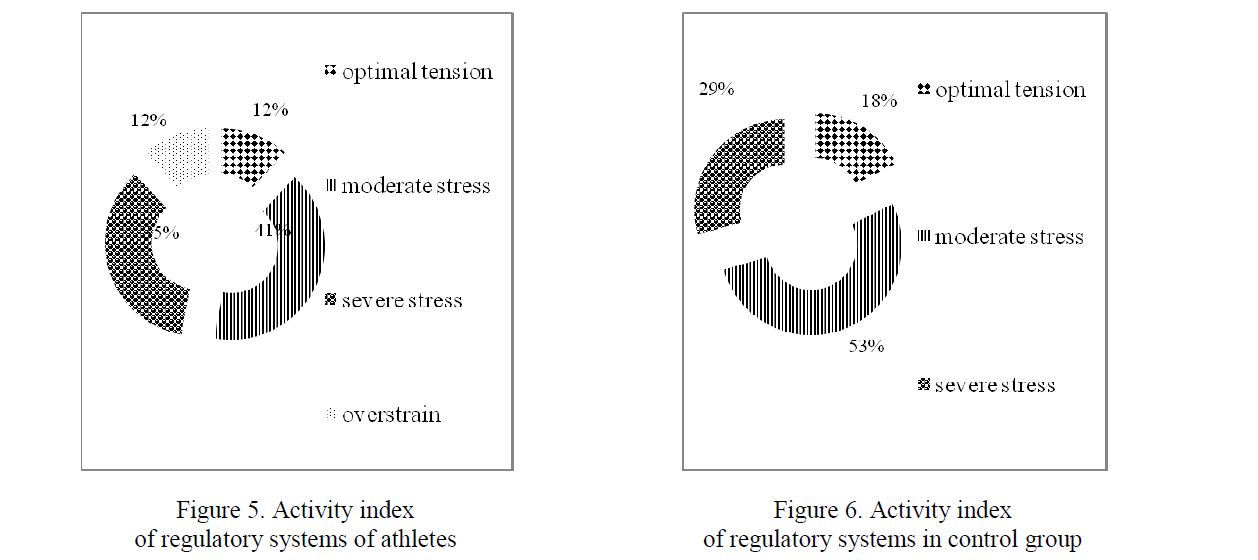The article presents the results of survey of two groups of male students (mean age 20 ± 2) from the Department of Physical Culture and Sports as well as the biology and geography departments. The heart rate variability was examined using a computerized complex «Varikard» (Russia). Estimation of heart rate variability was performed using mathematical statistics method of R.M.Baevsky. Cardiovascular system’s fitness was estimated by determining the type of response to the diving reflex using the method of cold-hypoxiahypercanic effect (CHE). There was a substantial stress and strain of regulatory systems at the majority of students of the Faculty of Physical Education and Sport, what shows a decline of adaptive reserves of the body, caused by excessive loads.
Regular physical loads lead to specific changes in the unit of circulation and in autonomic regulation of the heart rhythm which occur during both muscular work and period of relative calm [1, 2]. These changes are associated with the length of training, the intensity of training load and other factors [3]. Long-term exercising of physical culture and sport contributes to the increased productivity of the cardiovascular system and to the formation of a physiological «athlete's heart», a characteristic feature of which is the triad: bradycardia, arterial hypotension and myocardial hypertrophy [4]. Inconsistency between the level of preparedness of athletes and load requests leads to the development of overstrain of cardiovascular system, the emergence of preand pathological changes in organs and systems.
Investigating the mechanisms of heart rate regulation, you can get an objective picture of the functional state of the body, the adaptive capabilities of the regulatory systems, as well as the dynamics of their development. According to some authors [5, 6], the objective criteria for estimating the current functional status and physical fitness of athletes are physiological indicators, reflecting the state of mechanisms of vegetative regulation of cardiac activity.
In this regard, when examining the athletes the particular interest is presented by stress tests that concider indicators of HRV as a criterion for evaluation of early and latent changes in the functional state of the cardiovascular system. At the present time, during trainings a variety of training and competition loads are used, the volume and intensity of which vary depending on the goals and objectives of the stages of training and competition schedule. Their impact significantly affects the degree of tension of adaptation mechanisms [7]. The correct and rational use of physical activity causes significant changes of morphology and functioning of the cardiovascular system. The relationship between the type of vegetative regulation of heart rate and the level of functioning of the cardiovascular and respiratory systems of athletes, regardless of sports specialization was revealed [8].
According to data [9] activity of parasympathetic influences of the autonomic nervous system increases with the increase of total cyclic loads volume and speed training work. The activity of the sympathetic influences of the autonomic nervous system is enhanced with increasing number of starts and scope of the competition loads.
The rational organization of the training process is the leader in the training of athletes in higher education institutions, where they have both the training and the studying loads. For the proper construction and correction of training process it is necessary to have sufficient information about the dynamics of changes in the functional state of the organism occurring during trainings and about physical fitness of athletes. Physical activity has an effect on all body systems, so inconsistency between training loads and capabilities of an athlete, can lead to the breakdown of the processes of adaptation, development of prenosological states and pathological processes. Generally accepted methods for estimation of the functional state and physical fitness do not fully reflect the ongoing changes in the body of an athlete in the course of a year cycle of trainings [10]. Most, informative and sensitive method for estimation of the functional state and physical fitness can be considered an analysis of heart rate variability in rest and during functional tests.
Estimation of the functional state of the organism in which a significant role belongs to the level of adaptation of the cardiovascular system (CVS), is one of the major problems of athletes [11, 12].
In connection with the foregoing, the purpose of this study is: a comparative estimation of the regulatory systems' functional state of regularly exercising and not exercising sports students.
Research methods
Work was carried out on the basis of biological and geographical faculty of the E.A.Buketov Karaganda State University in the framework of the agreement on cooperation with the department of general physiology of biological faculty at St. Petersburg State University.
The study involved 44 male students with no bad habits at the age of 18–22 (20 ± 2) years old from the faculties of biology and geography and of physical culture and sports. Students were divided into two groups: one group consisted of students who exercise sports regularly with duration of training from 3 to 5 years. The second group — the control one, consisted of students, that are not regularly involved in sports.
Diving Reflex was imitated by CHE, which was carried out three times consecutively, with calm expiration immersing face in water with temperature 12–14 ºC. The interval between dives was 2 min. The duration of the first dive was limited by the first urge to breath, subsequent dives were made by willed effort [13]. During state of rest, before the dive, during the dive and in the process of recovery after cessation of apnea, ECG (in the second standard deviation), blood pressure and pulse were registrated. ECG was implemeted on a computerized complex for analysis of heart rate variability «Varikard» (Russia). Estimation of heart rate variability was performed by mathematical statistics method of R.M.Baevsky [14].
Type of reaction to diving was determined by the character of reflex bradycardia's development during apnea with face diving in water. Depending on the individual characteristics of the cardiovascular system to CHE examined students were divided into 4 types: highly reactive, reactive, paradoxical, unresponsive [15]. To characterize diving reaction the following indicators were used:
T — apnea time (dive — CHE);
(RR) max — interval (CI — cardiointerval)
(RR) max b — maximum cardiointerval in a background (record of initial state) (RR) min b — minimum cardiointerval in a background;
(RR) max che — maximum cardiointerval during the dive;
l — the latent period of bradycardia — is determined from the start of dive to R — Rche > R-Rmax b;
tmax che — time from the start of dive until (RR) max che (maximum CI during the dive); BI — bradycardia intensity = (RR) max che / (RR) max b;
Vbr — the rate of increase of bradycardia; it is calculated by the formula — Vbr = (RR) max che – (RR) max b / tmax che;
(R–R) min b > R–R < (R–R) max b; sometimes ECG can be stabilized with (R–R)-intervals that may be somewhat larger than (R–R) max b. In this case, the determining factor is stabilization of the ECG (Table).
Diving reaction type
T a b l e

Complex estimation of heart rate variability was made in accordance with activity index of regulatory systems (AIRS). It was calculated in points (0 to 10) using special algorithm that takes into account the statistical parameters, histogram indicators and data of cardio intervals’ spectral analysis. AIRS allows to differentiate varying degrees of tension of regulatory systems [16].
Statistical data processing was performed using Microsoft Excel.
Research results
Diving reaction of a person has a number of features connected with vegetative regulation and can be used to estimate the organism's resistance to stress. Depending on the nature of reflex bradycardia development caused by the reactivity of the vagus nerve, four types of diving reaction, reflecting the degree of tension of regulatory systems of the body were revealed [17].
According to data obtained during performing CHE, it was revealed that 23 % of students from the first group had reactive type of diving reaction (Fig. 1), similar reaction was observed at 35 % of students of the second group (Fig. 2). Reactive type is characterized by the gradual and rather long development of bradycardia. Long latent period and the gradual nature of bradycardia’s development indicate a high threshold of tactile and cold receptors of the skin, and generally indicates the body's resistance to cold and less severe tension of regulatory systems [18].
Highly reactive type of response was met in both groups in 24 % of cases. People with highly reactive type of response are characterized by the rapid development of bradycardia, while the duration of apnea is low. The short latent period of development and high rate of increase of bradycardia indicate a low threshold of activation of tactile and cold receptors of the face and nasal passages, which is typical for activation of the sympathetic component of vegetative nervous system and is an indirect indicator of tension of regulatory systems [19].
Unresponsive type was found at 35 % of students regularly engaged in physical culture and sports, and at 41 % of students who don't do regular exercises. Unresponsive type of reaction, is displayed with absence of any changes in response to CHE that can be caused by a predominance of intracardiac factors of «resistance» of the vagal stimulation and by the end of apnea a slight slowing of the heart rate may be observed, which disappears immediately after apnea is ceased. At the same time blood pressure increases significantly [19].
Among students of the first group 18 % of examined had paradoxical type of response to HBV while in the second group of students this type of response was not found. People with paradoxical type of reaction are characterized with tachycardia at the beginning of sleep apnea, which is gradually transformed into normocardia, then, by the end of apnea, or after its cessation bradycardia may develop. According T.I.Baranova (1994) physical training affects the character of the implementation of diving reaction doubly. There is a higher percentage of representatives paradoxical type among the well-trained athletes [20].

Figure 1. Type of implementation of diving reaction among athletes
Figure 2. Type of implementation of diving reaction in control group
According to data obtained in the result of researches of an overall effect of heart rate regulation it was revealed that normocardia (70±6,16) composed 41 % of students from the first group (Fig. 3), and of 82 % of students from the second group (70±4,14) (Fig. 4). Mild tachycardia was detected at 6 % of the students in the control group (80±2,11) and at 23 % of the students of the experimental group (84,5±2,38). 24 % of the students from the first group had severe tachycardia (92,3±3,2) while in the second group 12 % of students had severe tachycardia (96,5±6,3).

Figure 3. The overall effect of heart rate regulation among athletes
Figure 4. The overall effect of heart rate regulation in control group
Regular and methodically properly constructed sport exercising leads in most cases to a reduction of heart rate during rest. In our researches, moderate and severe bradycardia (48±) was found from students who exercise sport regularly in 6 % of cases respectively. Bradycardia was not found from students of the control group. The slow pace of heartbeat of well trained, accustomed to great physical loads people is the result of adaptation [21].
Thus, the studies of the overall effect of heart rate regulation suggest that heart rate decreases only at 12 % of examined students that are engaged in regular exercises. To estimate the degree of tension of regulatory systems, we also determined integrative activity index of regulatory systems of the organism (AIRS).
In our studies, the optimal tension (1,8±0,2) of regulatory systems was observed at 12 % of the examined students who do sports (Fig. 5), and at 18 % students in the control group. Moderate stress (3,5±0,5) of regulatory systems was noted at 41 % of the students involved in sports, while in the control group it was 53 % (Fig. 6). Severe stress (5,3±0,4) of regulatory systems was detected at 35 % of students of the first group and at 29 % students in control group. Overstrain of regulatory systems was found at 12 % of the students involved in sports, and in the control group overstrain of regulatory systems was not found. Exhaustion of regulatory systems was not identified in any group.

Figure 5. Activity index of regulatory systems of athletes
Figure 6. Activity index of regulatory systems in control group
Thus, the research showed that the regulatory systems of the majority of examined students that are engaged in regular exercises, function in the state of expressed stress and overstrain. This demonstrates the deterioration of the general current functional state and decreasing of adaptation reserves of the organism of students, due to regular phisycal loads, which can be viewed as excessive.
References
- Belotserkovsky Z.B., Lubina B.G., Koydinova G.A. Theory and Practice of Physical Culture, 2009, 1, p. 12–19.
- Aulik I.V. Determination of physical performance in the clinic and sports, Moscow: Medicine, 1990, 192
- Ivanova V. The functional state of cardiorespiratory system of athletes with different specificity of muscle activity in the preparatory and competitive periods of training: Ph.D. Dis., Moscow, 2010, 182 p.
- Achkasov E.E., Mashkovskiy E.V., Bogova O.T., Vulkan Sh. of Russian Academy of Med. Sciences, 2014, 5–6, p. 34–39.
- Baevsky М., Ivanov G.G. Variability of a heart rhythm: theoretical aspects and possibilities of clinical application, Мoscow, 2000.
- Ryabykina G.V., Sobolev A.V. The variability of a heart rhythm, Мoscow: Overlay, 2001, 200
- Physiology of adaptation processes, Ed. by O.G.Gazenko, F.Z.Meyerson, Moscow: Nauka, 1986, 635
- Zhuzhgov P., Shlyk N.I. Collection of materials of VI Intercollege. scientific and practical conference, dedicated to the 85th anniversary of higher education in the Urals, Tchaikovsky, 2001, p. 97–99.
- Belova E.L., Rumyantseva N.V. of sports science, 2009, 4, p. 29–33.
- Kudrya O.N. of the Novosibirsk State Pedagogical University, 2014, 1, p. 185–196.
- Gavrilova E.A. Athletic heart. Stress cardiomyopathy, Moscow: Sovetsky sport, 2007, 200
- Mikhailova A.V., Smolenskiy A.V. Physiotherapy and Sports Medicine, 2009, 7(67), p. 22–26.
- Baranova T.I. Guidelines for the use of technology-cold hypoxic-hypercapnic exposure. Department of General Physiology, Laboratory of structural and functional adaptations, Saint Petersburg: St. Petersburg State University Publ., 2008, 17
- Baevsky M., Bersenova A.P. Estimation of adaptation capabilities of the organism, and the risk of disease, Moscow: Medicina, 1997, 236 p.
- Galantsev V.P., Baranova T.I., Yanvareva I.N. Non-drug method of rehabilitation, prevention and improvement of the functional reserve of the human body, Russian Patent № 2161476, 2001, 10
- Baevsky M., Bersenova A.P. Evaluation of adaptive capacity of the organism, and the risk of disease, Moscow, 1997, 204 p.
- Baranova T.I. Mechanisms of adaptation to hypoxia diving: Dis. abstract … Dr. biol. sci., St. Petersburg, 2010, 32
- Baranova T.I. Sechenov Russian Physiol. J. 2004, 90, 1, p. 20–31.
- Baranova T.I. The mechanisms of functioning of the visceral systems: Thesises of docl. of Intern. Conf., St. Petersburg, 2001, p. 28–29.
- Baranova I., Vashchuk O.V., Galantsev V.P., Yanvareva I.N. Questions of of Physical Education of Students: Interuniversity col., Saint Petersburg: St. Petersburg State University Publ., 1994, 24, p. 105–109.
- Dubrovsky V.I. Sports medicine, Moscow: Vlados,